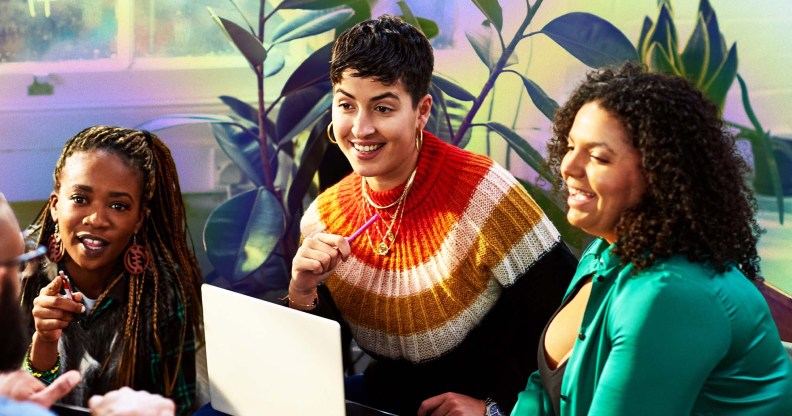Gay and lesbian adults more likely to be in full-time employment than straight people, figures show

New data from the Office of National Statistics shows that employers need to do more for inclusion. (Getty Images/PinkNews)
Gay and lesbian adults are more likely to be in full-time employment than straight people, new figures from the Office for National Statistics (ONS) show.
The ONS released its latest report on diversity in the labour market last week (25 September). Data from the 2021 census report showed that 64 per cent of lesbian, gay and bisexual adults are in full-time employment compared to 58 per cent of heterosexual adults.
Among gay and lesbian people alone, the figure stood just above 70 per cent.
This data point is one of the few glimmers of hope suggesting that inclusion and representation are gradually improving in today’s workplace, with the rest of the report indicating that members of most minority groups are less likely to be in full-time employment compared to their majority counterparts.
On census day (21 March 2021), there were 27.8 million adults aged 16 and over in employment.
Despite the fact there are more adult females than adult males in the UK, only 53 per cent of females are working compared to 61 per cent of males. The report also noted that this gender gap grows between the ages of 30 and 70.
The report says that the increased gender gap is “partially explained” by females leaving the labour market after they have children and the higher levels of female unpaid carers.
Disabled adults are significantly less likely to be employed than non-disabled adults, with an employment rate of 27 per cent compared to 65 per cent.
The severity of a person’s disability also plays a role, with those who report being “limited a lot” in their day-to-day activities having a lower employment rate than disabled adults who report being “limited a little”.
Even non-disabled adults with non-limiting health conditions were slightly less likely to be employed than those without any health conditions.
The report also revealed that 48 per cent of Muslim adults in England and Wales are employed – a lower proportion than other ethnic backgrounds. The report cites the younger average age of the Muslim population as an explanation, as well as economic inactivity due to caring responsibilities. Muslim women have the lowest employment rate of any religious group in the UK.
Time for employers to ‘step up’ and ‘do the right thing’
Today’s workers are placing greater value on D&I in the workplace than their predecessors: a separate poll from YouGov found that 66 per cent of UK workers said that the acceptance and inclusion of employees from all backgrounds are important to them when job searching.
Separate research conducted by recruiting agency Aspire found that business culture (including policies such as D&I), has become increasingly important to candidates. It was ranked as more important than work-life balance and a business’s Corporate Social Responsibility model.
Commenting on the ONS’s report, Terry Payne, global managing director at Asprie said: “While businesses recognise how important D&I is and many are taking strides towards true diversity, the latest findings from the ONS show there’s still a lot of work to do.
“Gender, disability, race, sexuality, religion or being a parent shouldn’t hold people back from employment; everyone has something to offer. There’s no reason why businesses can’t help to increase labour market participation for these underrepresented groups.”
Payne added: “It’s time for all employers to do the right thing and step up their approach.”
How did this story make you feel?

